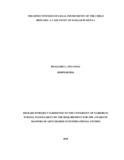| dc.description.abstract | In 2015, the total number of refugees in the world reached 21.3 million. Over half of these were children. The majority of these minors were unaccompanied, traveling alone without their families, trying to find a safer place to continue their lives. The government of Kenya is obligated to protect the rights of refugee minors in accordance with the United Nations Convention on the Children’s rights. The aim of this research is to investigate how effective the legal instruments are to human rights of these refugee children and how the instruments protect them in Kenya with Dadaab refugee camp being the case. Additionally, in this exploration, International law secures the privileges of displaced person youngsters as expressed in various arrangements and traditions, for example, the Universal Declaration of Human Rights (1948), the Convention Relating to the Status of Refugees (1951), the International Covenant on Economic, Social, and Cultural Rights (1966), the African Charter on the Rights and Welfare of the Child (1990) and the Convention on the Children rights (1990). Consequently, an extra motivation behind this exploration is to feature the authentic advancement of the privileges of displaced person kids through projects driven by states and non-states performing artists, and to stress the significance of kids' rights as a feature of current helpful mediations. This examination looks at how viable, are lawful instruments intended to secure outcast kids in Dadaab displaced person camp. The lawful structures are disclosed with respect to how universal law ensures the privileges of child displaced people and in addition the need hypothesis. Customarily all philanthropic guide comprises of three key columns, where the attention is on nourishment, medication and haven. The universal network has perceived that the privileges of displaced person youngsters are crucial, however more should be done to guarantee financing that would incorporate crisis reactions. This can be accomplished by fusing exile kids as an imperative column in helpful rights. The examination included investigations of worldwide and national lawful instruments/records, the advancement and security of outcast youngsters' rights in Dadaab and prospects and difficulties in the applicability of legitimate instruments towards the insurance of privileges of kids initiated by meetings with non-administrative associations and legislative foundations required with the assurance and care of the privileges of kids. The outcomes demonstrate that the Children rights have a solid position in authoritative archives, non-legislative associations and administrative establishments. The outcomes likewise demonstrate a differential consideration and insurance gotten by youngsters according to their ages. Additionally, there is no reasonable meaning of what sufficient consideration is, which made diverse translations by non-legislative associations and the legislature. The lawful watchmen whom are named to secure the child all through the haven procedure will give help, however not every day care. | en_US |



